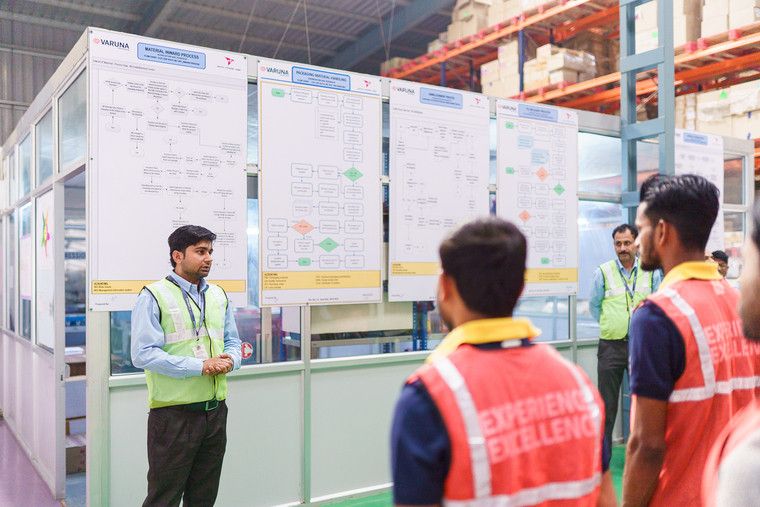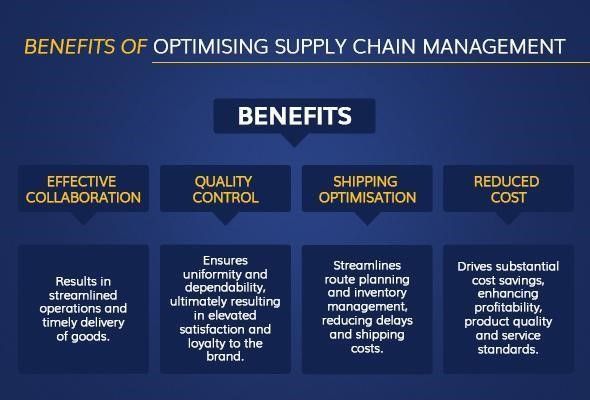SUPPLY CHAIN MANAGEMENT
Top 5 Factors to Enhance Supply Chain Management
23 Feb 2024, 5 MINUTE READ
A robust and efficient supply chain is essential for meeting the needs of both producers and consumers while adopting a comprehensive management approach. By integrating operations across multiple regions, the logistics department can enhance efficiency, simplifying the management of various components within the supply chain efficiency.
The supply chain market, valued at $32 billion in 2019, is projected to double by 2030, highlighting the critical importance of effective optimisation for sustained business growth. An efficient can swiftly identify and address disruptions, ensuring seamless product transportation uninterrupted operations.

Optimising Your Supply Chain: 5 Essential Strategies
The rapid expansion of the supply chain market has emphasised the critical need for efficient supply chain optimisation to achieve sustained business success. Below are some key strategies for achieving this goal.
Enhance Supply Chain Visibility:
Ensure your company's adaptability by strategically realigning processes and supply lines to face uncertainties effectively. Adopt emerging technologies such as blockchains, drones, and IoT to maintain supply chain resilience, logistics efficiency and future-proof your operations.
Select Dependable Suppliers:
Beyond mere cost considerations, prioritise suppliers known for their reliability and consistent performance. Conduct thorough research to identify suppliers with solid track records in quality, customer service, ethical practices, and packaging standards, ensuring seamless delivery of high-quality products to customers.
Fine-tune Supply Chain Strategies:
Drive success by optimising your supply chain and logistics services for efficiency, cost-effectiveness, and reliability. Regularly reassess your strategy to ensure alignment with your business objectives. Seek out opportunities for cost savings, such as negotiating discounts and exploring alternative logistics providers.
Embrace Supply Chain Automation:
Harness the power of digital technologies like Robotic Process Automation, Artificial Intelligence, and Machine Learning to automate and streamline operations. From automated sorters with RFID technology to drone delivery systems, leverage automation to enhance speed, accuracy, and efficiency throughout your supply chain management company.
Harness Modern Technology:
Leverage cutting-edge technology to optimise Supply Chain Management processes. Invest in a robust Warehouse Management System (WMS) to facilitate seamless tracking, documentation, and analysis, empowering data-driven decision-making and insights generation. Complement this with transport management software for integrated operations management via a centralised control panel, further enhancing SCM efficiency and effectiveness.
Benefits of Optimising Supply Chain Management
The below flowchart explains the top benefits and their results:

Emphasising the selection of trustworthy suppliers and logistics companies in India, fostering supply chain sustainability, and ensuring smooth information exchange within your organisation are paramount steps toward cost reduction and heightened customer satisfaction. The construction of an effective supply chain relies on meticulous analysis of how alterations in the management system influence operational expenses, service provision, working capital, and company revenue. By prioritising these aspects, businesses can streamline operations, minimise wastage, and deliver products or services more efficiently, enhancing financial performance and customer experience.
Frequently Asked Questions
Q1: What are the 5 pillars of the supply chain?+
The Five Pillars of Supply Chain for include Planning, which involves demand forecasting, inventory strategy, and capacity planning to ensure readiness for market fluctuations. Sourcing is the process of selecting suppliers and managing procurement to maintain continuity and quality of supply. Manufacturing covers the actual production processes, quality assurance, and scheduling to meet delivery timelines. Delivery, or logistics and distribution, ensures that goods reach the end-user through efficient warehousing, transportation, and order fulfillment systems. Lastly, Returns involve managing reverse logistics, recycling, or disposal, and addressing customer warranty issues, which is essential for service recovery and sustainability.
Q2: What are the 7 key issues of supply chain management?+
organizations frequently face include lack of visibility, which hampers decision-making across multi-tier supplier networks. Inventory imbalances, such as overstocking or stockouts, often occur due to poor forecasting. Many firms suffer from a technology adoption gap, missing out on the benefits of automation, IoT, or predictive analytics. Supply-demand mismatches caused by market volatility can disrupt operations. Supplier reliability and geopolitical risks also pose challenges, especially when sourcing is concentrated. Lastly, sustainability and ESG compliance are increasingly crucial, with regulatory and consumer pressure demanding greener, more transparent operations.
Q3: How to optimize your supply chain management?+
Optimising a supply chain involves a strategic blend of digitization, integration, and operational agility. Organizations must digitize end-to-end operations using IoT, AI, and real-time analytics to improve forecasting and responsiveness. Integrated systems such as ERP, warehouse management systems (WMS), and transport management systems (TMS) enhance coordination and visibility. Building strong supplier partnerships with performance-linked contracts ensures reliability and flexibility. Adopting lean inventory practices, like Just-in-Time (JIT), helps reduce holding costs and wastage. Data-driven planning, supported by predictive analytics, enables better demand-supply alignment. Automation in warehousing and logistics—such as robotic picking or electronic invoicing—further boosts efficiency. Additionally, leveraging multimodal logistics and freight corridors can help reduce transit times and costs
Q4: How can we improve the efficiency of the supply chain?+
Efficiency of a supply chain requires both strategic and operational interventions. One of the most impactful measures is implementing real-time tracking and visibility, which enhances decision-making and accountability. Optimizing warehouse layout and design reduces internal movement and speeds up order processing. Reducing lead times through local sourcing or better supplier planning improves agility. Standardizing packaging and SKUs streamlines handling and shipping. Workforce training ensures adherence to processes, enhances quality, and boosts productivity. Finally, diversifying sourcing strategies mitigates disruptions and strengthens supply resilience in a volatile global environment.
Related Insights
SUPPLY CHAIN MANAGEMENT
The Crucial Role of Humanitarian Logistics
30 Sep 2021, 4 MINUTE READ
SUPPLY CHAIN MANAGEMENT
6 Inventory Management Strategies To Maximise Gains
3 Jul 2025, 6 MINUTE READ
SUPPLY CHAIN MANAGEMENT
Enhancing Supply Chain Resilience with Prescriptive Analytics
20 May 2025, 4 MINUTE READ
SUPPLY CHAIN MANAGEMENT
Emerging Supply Chain Trends That Will Redefine 2025
28 Jan 2025, 4 MINUTE READ
SUPPLY CHAIN MANAGEMENT
Building a career in Logistics and Supply Chain Management
13 Oct 2021, 6 MINUTE READ
Drive efficiencies throughout your supply chain with our technology-enabled services
View Services